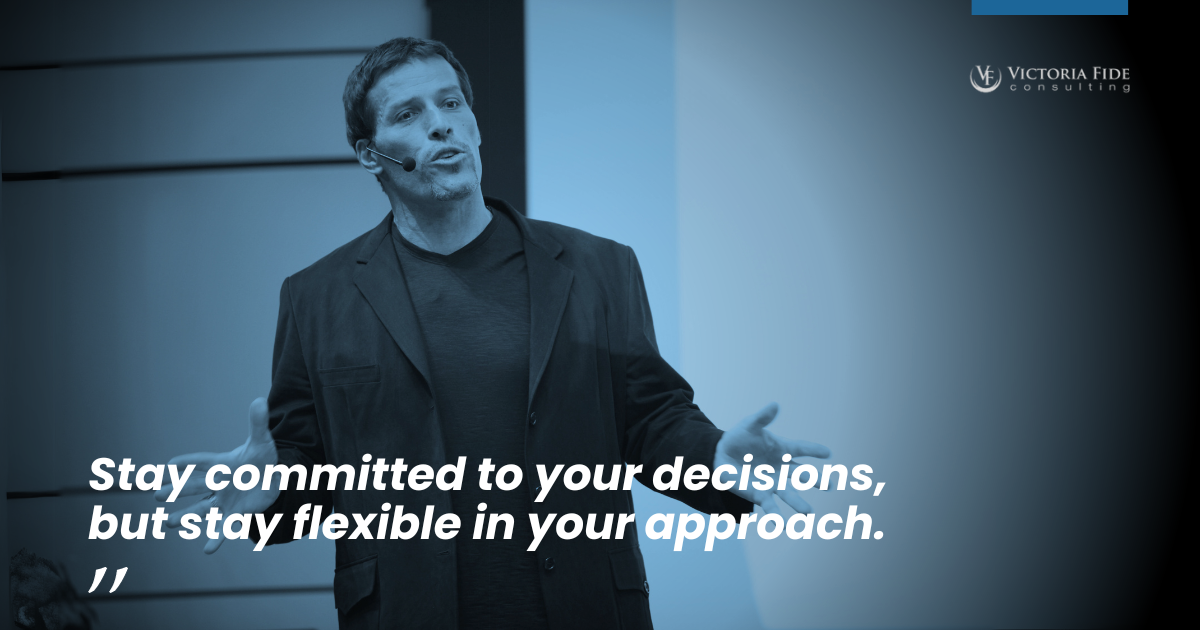
CBA: The Antidote to Analysis Paralysis in Digital Transformation
The Sage Wisdom series is produced by Victoria Fide Marketing with input and oversight from our leadership team and industry SMEs.
Tony Robbins is one of the most famous motivational speakers in the world. He is an American author, coach and speaker known for his seminars and self-help books including “Unlimited Power” and “Awaken the Giant Within.” He was raised in an unstable, chaotic, and abusive household, and he left home at the age of 17. He didn’t let that stop him, however. He began to pursue a career in seminars and became a motivational speaker, focused on helping people overcome their personal challenges. He has worked on an individual basis with public figures such as Bill Clinton, Hugh Jackman and Jason Tuck, and has also counseled businessmen like Peter Guber, Marc Benioff, and Steve Wynn.
Robbins’ words have helped millions of people in their personal and professional life, and his quote, “Stay committed to your decisions but flexible in your approach,” perfectly encapsulates the principle of CBA (Current Best Approach) in digital transformation (DX) initiatives. CBA is an agile strategy that enables forward movement during projects even when there is missing information. Unfortunately, some people are resistant to this approach because they are under the impression that it requires completely pivoting away from their previously established goals or approach. In this article, we will examine what CBA is – and isn’t – and how to leverage it to bring your transformational initiative to a successful completion.
Understanding Current Best Approach (CBA)
Organizations adopt DX strategies with the aim of attaining specific business goals. These fundamental objectives act as the driving force throughout the entire DX journey. By embracing the principle of Current Best Approach (CBA), project leaders can effectively pursue organizational goals using the most suitable approach based on the available information. It is crucial to acknowledge that as new information emerges, the optimal approach can – and should – be revised accordingly. This adaptive mindset ensures that the organization remains agile and responsive to evolving circumstances, increasing the odds for successful DX initiatives.
DX projects carry inherent risks that organizations must navigate. According to statistics, a staggering 70% of digital transformations end in failure. The fear of such failures can be paralyzing for project leaders, leading to hesitation and avoidance of costly mistakes that could jeopardize the project’s success, and even their own job security. The stakes are high in large digital transformations, and time is not on your side. Every moment wasted in indecision depletes valuable company resources and diminishes the return on investment (ROI).

Free PDF Download
In the rapidly changing digital landscape, more and more companies are desperately trying to keep up with the competition. Download “The 10 Biggest Mistakes Businesses Make in Digital Transformation” for free today to learn how to use DX to radically transform your business and gain an edge over your competitors.
While it is crucial to avoid making hasty decisions, it is equally necessary to move forward with the available information and be prepared to adjust as necessary. Balancing commitment to your goals with a flexible approach is a key principle in achieving success in digital transformations. By staying focused on your objectives and remaining adaptable to changing circumstances, you can increase the chances of a successful outcome.
In summary, navigating the complexities of DX projects requires careful consideration and a balance between commitment and flexibility. By doing so, organizations can mitigate risks and increase the likelihood of achieving their desired outcomes.
3 Common Misconceptions About CBA
In our experience, we’ve found that resistance to adopting CBA is often rooted in several misconceptions and fears. One prevalent issue is the inclination to wait for more information. While data-driven decisions are undoubtedly vital, prolonging the decision-making process can prove costly. Time, being an essential resource in digital transformations, is not always on your side. Organizations need to learn to utilize the available information and make informed decisions promptly.
Another common cause of resistance is the fear of making the wrong decision. Here, the beauty of CBA shines through. It is inherently flexible and adaptable, allowing for course corrections based on new insights or changing circumstances. This flexibility ensures that even if a decision doesn’t pan out as expected, it can be re-evaluated and adjusted as necessary.
Finally, there is a fear of pivoting away from objectives. This fear often stems from misunderstanding CBA’s purpose. CBA does not advocate for veering away from objectives, but rather embraces the idea of flexibility in the approach to achieving those objectives. In the words of Tony Robbins, “Stay committed to your decisions but flexible in your approach.” By understanding and addressing these fears, organizations can leverage CBA more effectively, thus increasing their chances of success in DX initiatives.
Case Study: Applying CBA to an Organizational Change Management Strategy
Let’s look at what CBA looks like within an Organizational Change Management (OCM) Strategy. An organization recognized the need for a new enterprise resource planning (ERP) system. A decade or so ago, they had implemented an ERP system that resulted in significant inefficiencies, requiring several years to recover their previous level of efficiency. As a result, the same team harbored deep reservations about their current implementation and were highly skeptical of the efficacy of the proposed methodology.

Transformation is not easy, but it doesn’t have to be impossible. Take control of your project’s success today and schedule a free 30-minute consultation to find out how Victoria Fide can equip you for transformational success.
The initial goal was clear – a successful ERP implementation. After conducting an initial analysis to gather information to use for the OCM strategy, the consultants’ approach was to build key relationships with project sponsors and earn trust by establishing buy-in on the risk management strategy.
However, upon conducting surveys and interviews as the implementation progressed, it became apparent that the current approach was not addressing everyone’s concerns adequately. Certain key individuals felt overlooked, signaling a need to revise the approach.
In line with the principles of Current Best Approach (CBA), the OCM strategy was realigned. The new approach included dedicating more time to these individuals and teams, ensuring their concerns were heard and addressed.
The underlying decision to surface and address issues remained consistent, but the approach was flexible, adapting to the new information. As a result, the skeptics and specific leaders began to see the benefits of the process. Observable effectiveness and efficiency in the new approach led to an increase in trust and the realization of a larger return on investment (ROI).

Achieving Agility in the Dynamic Business Environment
As we conclude, it’s worth circling back to Tony Robbins’ wisdom: “Stay committed to your decisions but flexible in your approach.” This mantra encapsulates the very crux of successful DX initiatives. The dynamic nature of today’s business environment necessitates that while we remain steadfast in our objectives, we must be willing to adapt our approach based on the most current and relevant information available.
In both our personal and professional lives, agility forms the bedrock of progress and growth. The ability to pivot and adapt to changing circumstances not only increases our resilience but also opens up opportunities that might otherwise remain unnoticed. In the professional sphere, particularly in DX projects, this agility ensures that we can respond effectively to the evolving digital landscape and maximize our return on investment in large and complex initiatives.
To embrace an agile mindset and take advantage of CBA, consider investing in DX experts. With their guidance, you can navigate the complexities of DX initiatives more efficiently, making informed, timely decisions based on the current best approach. This will ensure that your path to achieving your goals remains clear and well-defined, regardless of the challenges that may arise.
Subscribe to our weekly LinkedIn Digital Transformation Success newsletter and get notified of each new edition.
